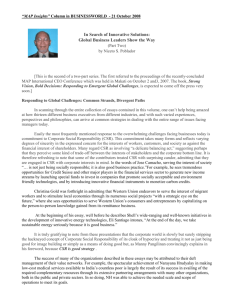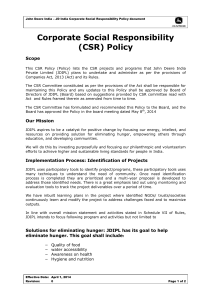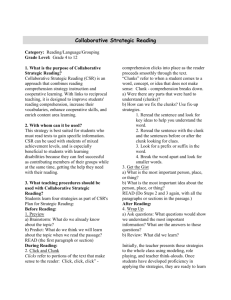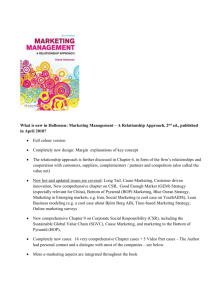Matt Collier EDU 332 IRIS module Dec. 1 2014 A Reading
advertisement
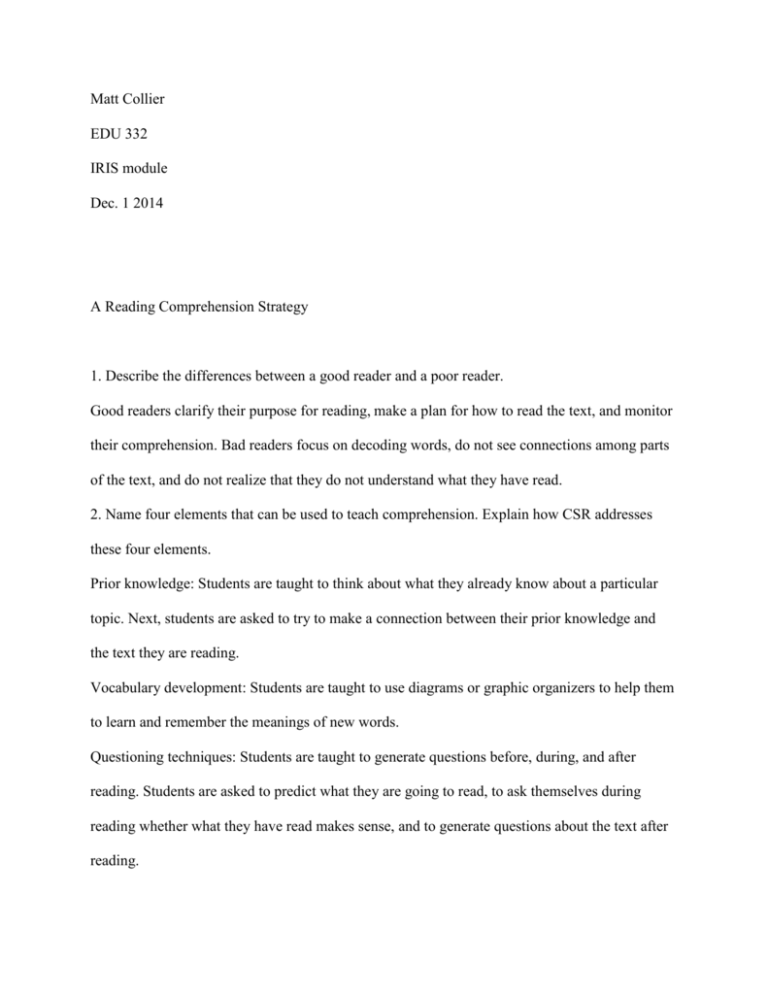
Matt Collier EDU 332 IRIS module Dec. 1 2014 A Reading Comprehension Strategy 1. Describe the differences between a good reader and a poor reader. Good readers clarify their purpose for reading, make a plan for how to read the text, and monitor their comprehension. Bad readers focus on decoding words, do not see connections among parts of the text, and do not realize that they do not understand what they have read. 2. Name four elements that can be used to teach comprehension. Explain how CSR addresses these four elements. Prior knowledge: Students are taught to think about what they already know about a particular topic. Next, students are asked to try to make a connection between their prior knowledge and the text they are reading. Vocabulary development: Students are taught to use diagrams or graphic organizers to help them to learn and remember the meanings of new words. Questioning techniques: Students are taught to generate questions before, during, and after reading. Students are asked to predict what they are going to read, to ask themselves during reading whether what they have read makes sense, and to generate questions about the text after reading. Opportunities to practice new skills: Students are given ample time in the day for independent reading and are encouraged to share what they have read. 3. What are the four reading strategies that make up CSR? Explain each. Opportunity for practice — Because CSR incorporates multiple strategies, students will require time and opportunity to learn each strategy before they are able to use them effectively in combination. The teacher instructs the students on how to use each strategy until students are able to perform it independently. Support for students — Once the students have mastered the strategies, the teacher should introduce longer sections of text (e.g., first paragraphs, then sections, then chapters). Teachers should also help students to make connections between the content and their prior knowledge. Student progress — As students utilize the CSR approach, they will apply each strategy in turn. It is beneficial for students to record their thinking for each strategy in their learning logs. Students use learning logs to: Record their predictions, clunks, gists, and wrap up review questions. Create a permanent record so that teachers can review their progress. Study for future tests and quizzes on the material. Keep track of their learning and create a basis for follow-up activities 4. Imagine that you are a fifth-grade social studies teacher. Having decided to implement CSR, you have divided your students into groups of five. Of the six roles described in this module, which five would you select for the groups? Explain. Stage 1: Discussing The teacher introduces the steps of the strategy and highlights the strategy’s advantages and benefits. The teacher explicitly explains what the strategy is for, how it is used, and in what circumstances it is useful Stage 2: Modeling The teacher models each reading strategy and each group role, and explains their integrated use to the class as a whole. One effective method of modeling is for the teacher to apply the strategy (or strategies) to a passage while thinking aloud for the class Stage 3: Guided Practice Following the modeling phase, the teacher creates opportunities for students to practice the strategies and roles. During this practice time, the teacher guides students through the steps Stage 4: Independent Practice Once students have achieved some familiarity with each strategy, they are ready to practice them independently. The same is true of the roles. The teacher will monitor students’ practice and offer corrective feedback 5. In this module, you learned about two methods of teaching group roles. Identify and describe both methods. Select the method you would use to teach group roles. Explain your preference. Discussing The teacher introduces the steps of the strategy and highlights the strategy’s advantages and benefits. The teacher explicitly explains what the strategy is for, how it is used, and in what circumstances it is useful. Modeling The teacher models each reading strategy and each group role, and explains their integrated use to the class as a whole. One effective method of modeling is for the teacher to apply the strategy (or strategies) to a passage while thinking aloud for the class My preference is to lead a discussion in class leading them to what they need to know.






